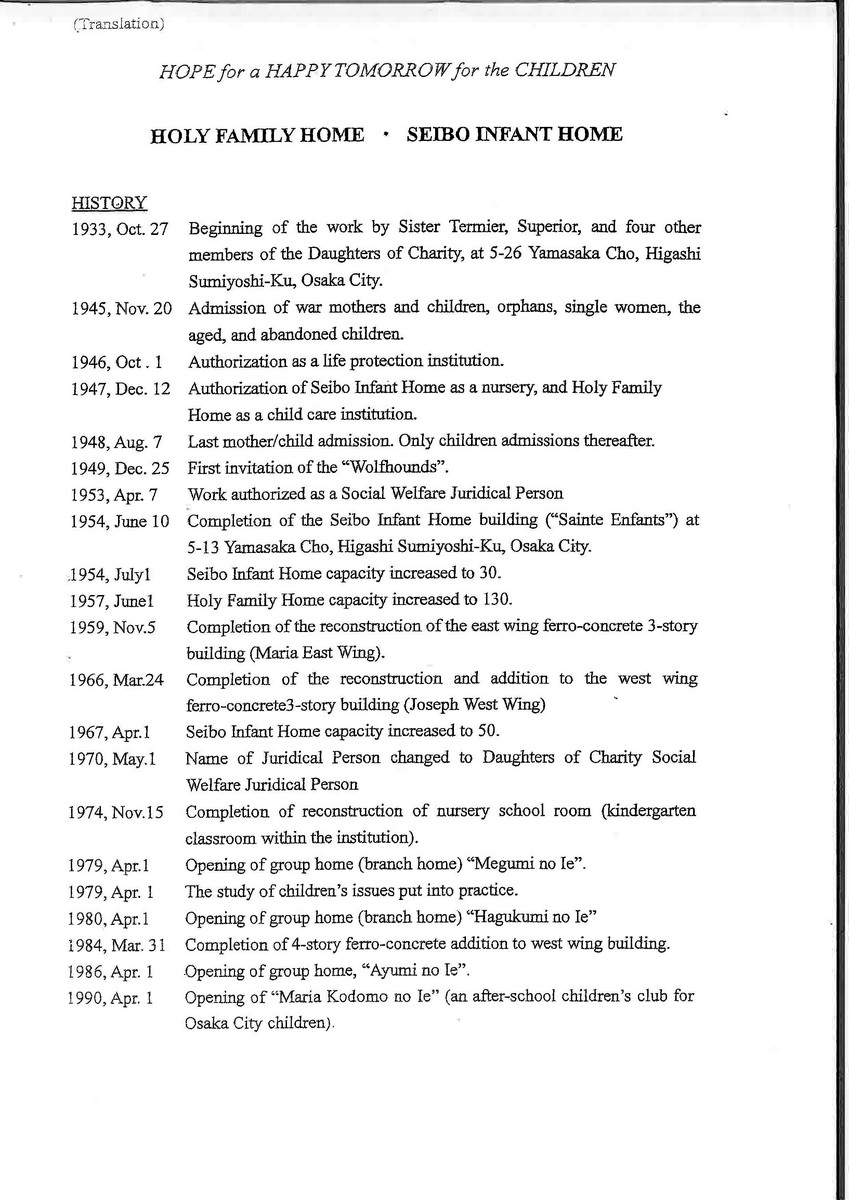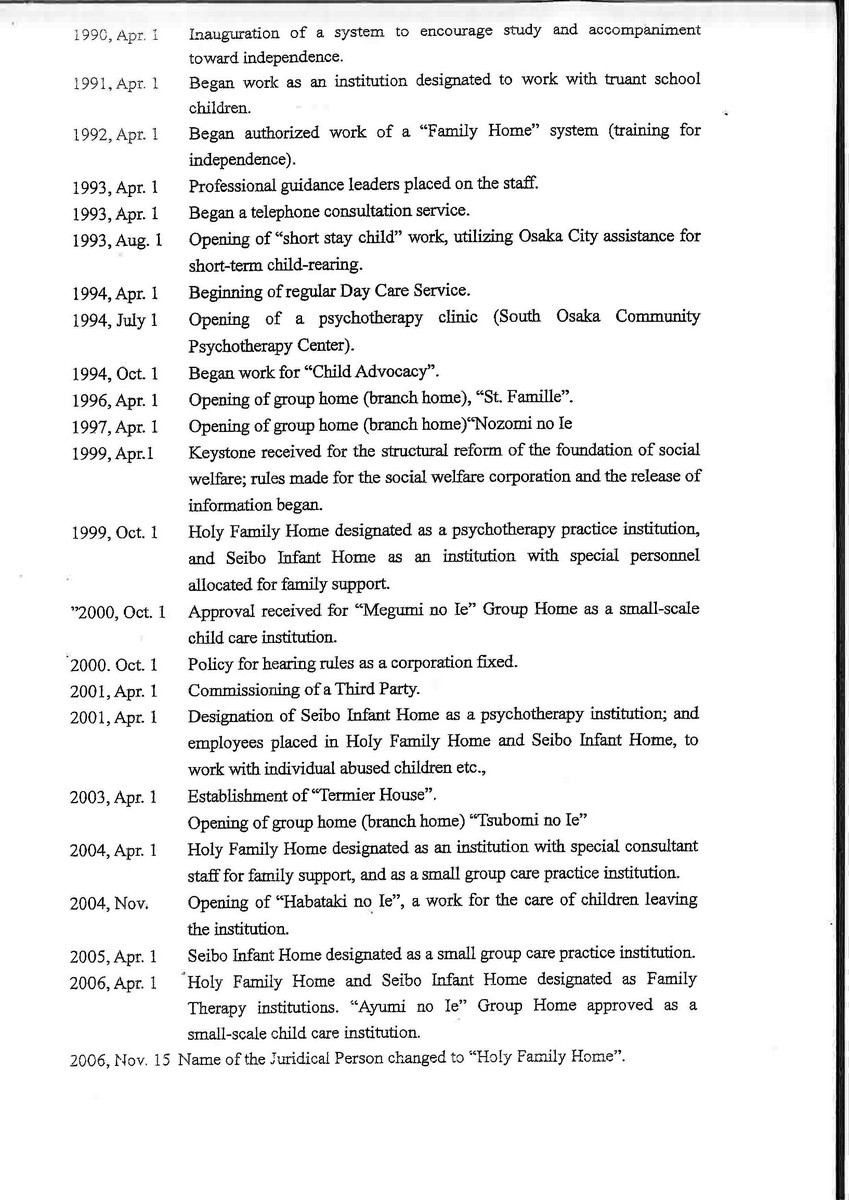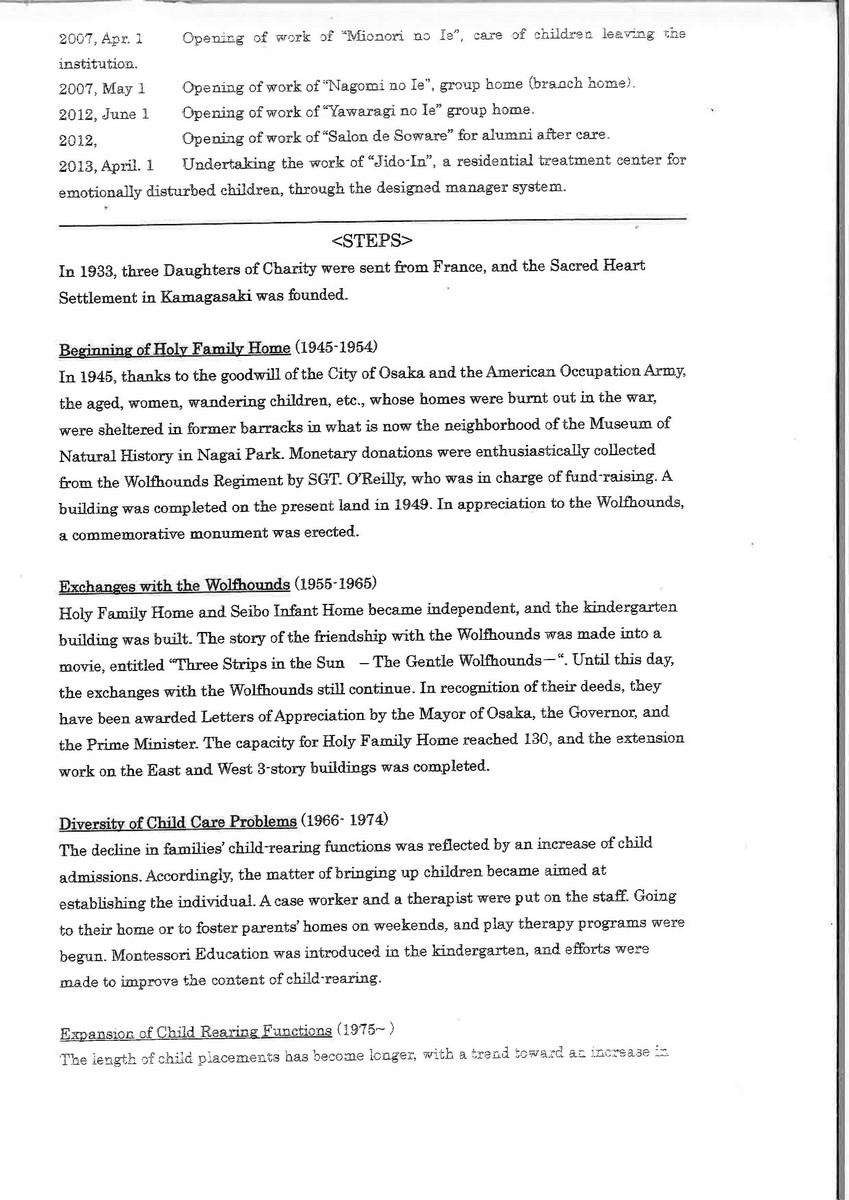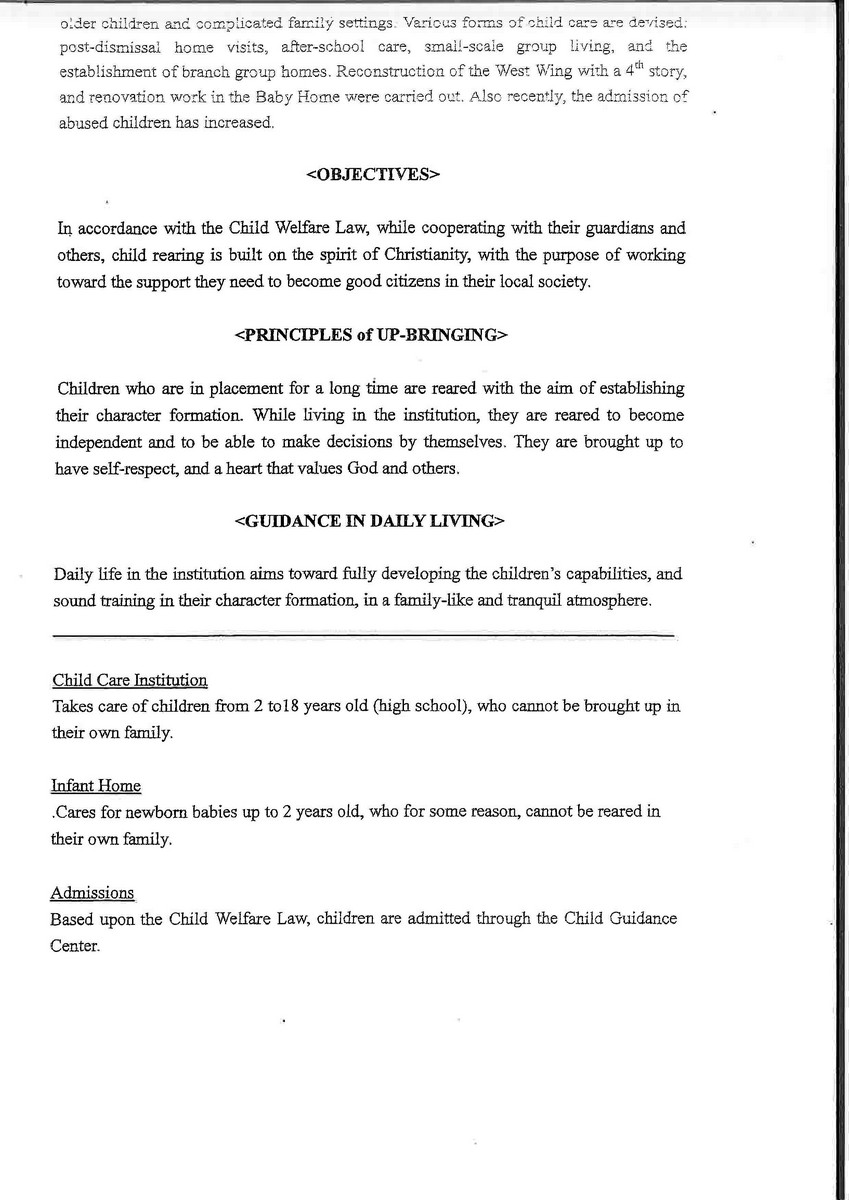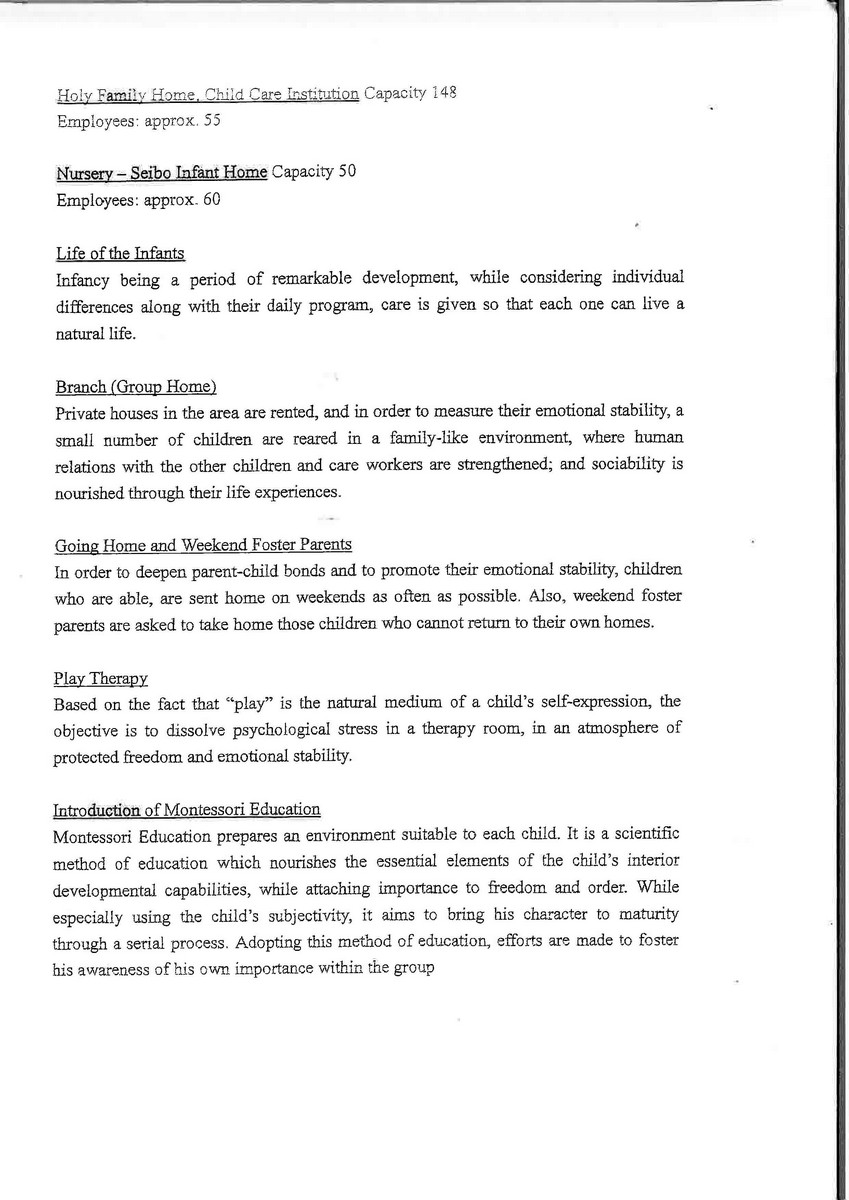Holy Family Home History
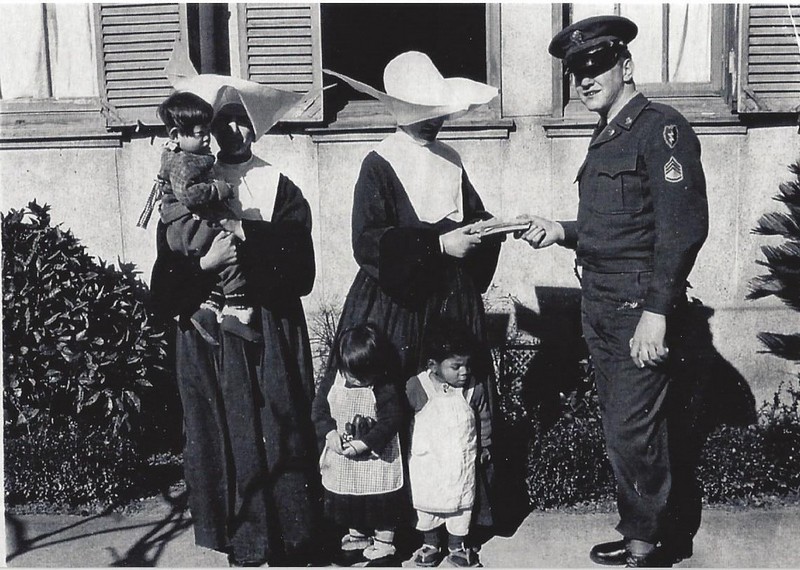
The Holy Family Home was established in Osaka, Japan by the Sisters of Charity of St. Vincent de Paul. Their mission was to house and care for the many orphans living in Osaka following the devastation of WWII.
The 27th Infantry Regiment Wolfhounds were stationed in Osaka Japan during the Occupation following WWII. After becoming aware of the Holy Family Home and the plight of these innocent children in 1949, the Wolfhounds dedicated themselves to making life better for the children of the home.
The Wolfhounds began “Passing the Hat” to collect funds for the orphanage, and dedicated their free time to building a new home for the children. “Pass the Hat” became a payday tradition, one that all Wolfhounds gladly contributed to.
Nothing but the highest credit must be given these American men for the depth of compassion and caring shown to Japanese orphans after a devastating war for all sides.
In 1950 the 27th Infantry Regiment was one of the first American units sent to Korea. When the time came to deploy, the soldiers believed that the orphanage was in peril. A week before their first payday in Korea, soldiers reaffirmed their commitment to Holy Family Home and to the surprise of the Sisters, the Wolfhounds contributions kept coming. The funds received from the soldiers during the years of occupation during the Korean War helped build a new orphanage complex that greatly improved the lives of the children.
The last payday in June of 1951 was a memorable one. The Wolfhounds raised a record breaking sum of $10,400 for Holy Family Home – over $92,000 today!
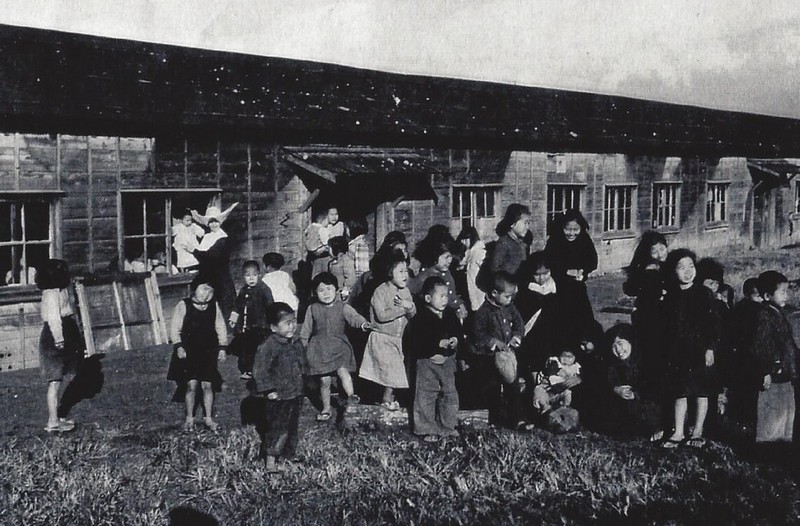
As a result of their efforts with the Holy Family Home, the Wolfhounds — already renowned as fierce fighters — earned a new nickname, “The Gentle Wolfhounds.” Their generosity to the orphanage became the focus of much public attention with features in the New Yorker, Life Magazine, and national newspapers. In 1955, the Columbia Pictures film, “Three Stripes in the Sun” told the story of Sergeant Hugh O’Reilly and the events surrounding this unique relationship between the Wolfhounds and Holy Family Home.
It is impossible to separate the actions of Sergeant Major Hugh O’Reilly from the association of the 27th Infantry Regiment and the orphanage. He was the catalyst and remains a source of inspiration to generations of Wolfhounds. But as Sergeant Major Hugh O’Reilly insisted, “the special relationship between the Holy Family Home and Wolfhounds is greater than one man; it has become part of the Wolfhound’s identity and lives on as a lasting symbol of American compassion.”
Every year since 1957, the Wolfhounds have hosted children from the Holy Family Home for a once-in-a-lifetime trip in Hawaii. Another tradition began the following year when the Wolfhounds sent two soldiers to the Holy Family Home to act as “Father Christmas,” bearing gifts for all the children.
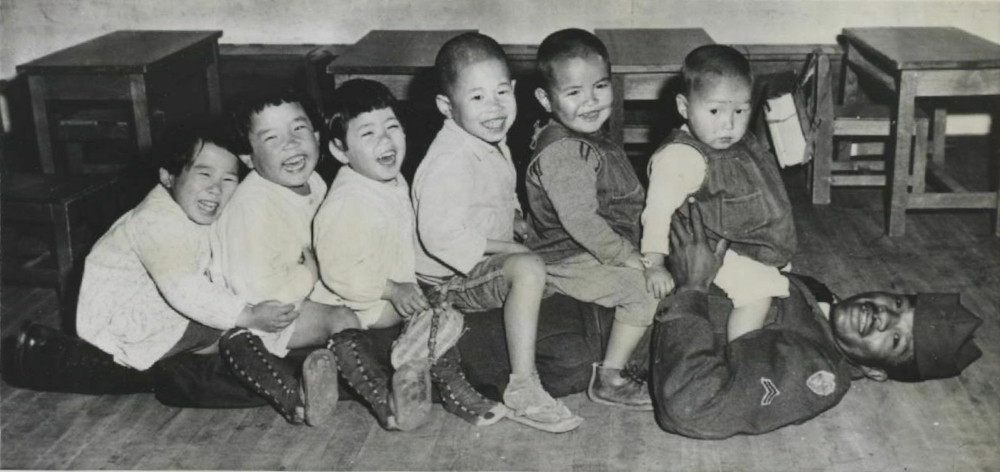
How Peace Bridge Came to Be
By Hugh O'Reilly, Jr.
From the Wolfhound Pack Fall/Winter 2020 Newsletter
Greetings fellow Wolfhound Pack members and Aloha from Hawaii! Hoping that this finds you all healthy and well as the covid pandemic drags on…
As promised, I’ve finally gotten around to relating the history of Peace Bridge. Not sure why it was so hard to write. Perhaps because – like everything else in life – the story isn’t a linear one.
To say that one person was responsible for starting Peace Bridge would be inaccurate. There never was an intent to create the organization, in fact it came about (not taking into account higher powers) as an accident. This said, there were three people who were key in laying the groundwork and mission for Peace Bridge – my father (SGM Hugh O’Reilly), Mr Akio Aoyama, and Drew Meyerowich…
In the months before my father’s passing he would often speak to me about continuing his work with the Wolfhounds and Holy Family Home. I repeatedly let him know that it was not for me. After all, what did I know about the Army or Wolfhounds? The Legacy and Holy Family Home were something I was certainly aware of, but I didn’t have the same personal connection as he did. I gently let him know that he should “speak with his buddies at the Wolfhounds” for a solution.
But Dad was persistent, and he always found some way to steer conversations back to his beloved Wolfhounds and the Holy Family Home Legacy – and of the importance to continue. While I remained steadfast in refusing to take the reins – hearing him go on (and on) actually helped me to gain a better understanding of the Legacy.
Growing up, I of course knew about the ‘tradition’, but I was only a peripheral participant. My usual role was to stand in the back of the room at arrival ceremonies and exchange niceties with a slew of nameless soldiers. Dad’s crash-course made me begin to understand what an incredible commitment it had been for the Wolfhounds and my eyes began to open to what a truly unique situation this was.
Throughout the course of my father’s illness he would often speak with Mr Aoyama (through my mother of course...despite years of exposure, Dad’s Japanese was limited to a few select words mom would never let him use in public).
As you may know, the Wolfhounds made a decision in 1992 to no longer financially support the Holy Family Home traditions of summer and Christmas visits. Dad was determined to see the Legacy endure, so he turned to a family friend, Mr. Akio Aoyama.
Aoyama San was a wealthy Japanese industrialist. He had no direct connection to the Holy Family Home (in fact he lived hundreds of miles away), nor with the Army. But my father’s passion – and Aoyama’s desire to “do the right thing” -- sold him. Mr Aoyama immediately agreed to fund the annual summer and winter visits. Without any need for recognition he continued to do so via an annual gift of $10,000 until 2006 – the year of my father’s passing. These funds covered expenses for the annual summer visit of orphans, as well as the Christmas visit by two soldiers from the Wolfhounds with gifts for all.
As his death approached, my father’s overarching concern was for the Legacy. He met with Wolfhounds daily, and asked Mr Aoyama to commit to supporting the cause after he passed.
At this time Mr Aoyama was in failing health himself. He couldn’t make a long term commitment because he was unsure what would happen to his family and his business. However he agreed to send my father a final, generous donation.
Dad was a stubborn guy (clearly a Wolfhound trait), and he took his sweet time to go to his final rest. He actually lived years longer than the doctor’s initial forecast. Even at the end he hung on adamantly for months. I’m convinced it was because dad had a plan, and wasn’t going to go until he knew everything was in place.
I’m a slow study, so in retrospect the extended time was a good thing. It gave me more opportunities to learn about the Wolfhounds, Mr Aoyama, and to spend time with Drew Meyerowich…
Drew was a revelation to me – a larger-than-life, gung-ho soldier, straight out of central casting. Everything he did was big, and LOUD! I spent a lot of time with him at the hospital and at my parent’s home as my father was dying.
Drew was my first real exposure to a Wolfhound. In time I learned to see past the GI Joe facade to realize that this was an intelligent, committed man who clearly loved ‘his’ Wolfhounds and my father. It also became obvious to me how vitally important the Wolfhound / Holy Family Home Legacy was to Drew. As my friendship for him grew, so did my respect. Most importantly, Drew humanized the Wolfhounds for me.
When my father passed, Drew broke several volumes of rules to ensure that dad was given a funeral that DREW felt was in keeping with the love and respect he felt for my father. And it showed.
Those three men -- SGM Hugh O’Reilly, Mr Akio Aoyama, and Drew Meyerowich – through their stories, their generosity & compassion, and their leadership created the foundation which Peace Bridge was built upon.
Shortly after my father’s passing, the annual summer visit of orphans to Hawaii took place. My family was there, as was Drew and a large contingent of Wolfhounds. This was a cathartic moment for me. As ‘eldest son” I could no longer stand in the back of the room. I was forced to interact with the attendees, but the real life-changing moment for me was seeing the kids come down the hall and into the meeting room.
I’d seen this many times before, but this time was different. This time I was lent my father’s perspective through his recent tutelage. I saw four kids that had never been on a plane before, greeted with an outpouring of love by a roomful of strangers, and I knew that this was the best day of their lives. In that same instant I KNEW why my father and generations of Wolfhounds had devoted their time and money to sustain this relationship. I also realized that my being there was yet another part of my father’s grand plan. I have no doubt that he timed his passing to ensure that I would be left to stand in for him, and that Drew would be in command.
Particularly resonant for me was the personal epiphany that “this was the best day of their lives”. I asked myself how could that be, how could your best day happen at the age of 10? Each day I look forward to this one being my next “best day of my life”. Surely there was something we could do to give these kids the same gift of hope and dreams of the future we all enjoy.
Feeling more than a little shanghaied by the combined influence of the ‘Terrible Trio’ (SGM Hugh O’Reilly, Mr Akio Aoyama, and Drew Meyerowich), but equally full of resolve, I spoke with my mother about continuing the Legacy. The first thing we did was to meet with Kent Keith – a family friend and attorney who was close to my father. The name was his invention (inspired by the book Mr Aoyama wrote, “A Bridge of Love from East to West”) and drafted all the legal documents. Kent became our first president.
Next we turned to family friends who were not only leaders in the community, but also familiar with the story. Mark James and Wayne Takahashi were the first -- and remain on the board to this day.
The three most important founding points for all of us were:
- That we would do our best to ensure that the Legacy should not only endure, but grow. From day one, we spoke of new initiatives beyond the annual summer and Christmas visits to enrich the children’s lives. College scholarships have been top of mind.
- That Peace Bridge would not be an O’Reilly Family organization. We wanted it to be a group of people who were inspired to do the right thing, without any conflict-of-interest. As such, only one O’Reilly may serve on the board at a time, and no O’Reilly shall ever be president.
- That we shall provide continuity throughout changes of command, deployments, etc.
Throughout this formative process there were so many people who helped to give us counsel and support – COL(R) Tom Guthrie, LTG(R) Bob Foley, and LTG Walt Piatt to name just a few. As time has gone on I have met many more bright and dedicated leaders who have all contributed to Peace Bridge in one fashion or another. Today many of those individuals sit on our board.
Peace Bridge has now been in existence for 13 years. We remain a 501c3 non-profit (and part of the Combined Federal Campaign), and led by an all-volunteer board. Most have never even been in the Army, but we are bound together by a dedication and mission “To do the right thing”.
Over the years we’ve developed a better working relationship with active duty Wolfhounds and they are now contributing to some of the visit expenses and much of the coordination. Peace Bridge continues to pay for all airline tickets for the children as well as for the Wolfhounds who visit at Christmas, and baggage fees for hundreds of gifts at Christmas. In addition we coordinate with local sponsors to organize special events where the orphans are treated like VIP’s by the community.
Particularly exciting for us is the new relationship with the Wolfhound Historical Society. Chuck Dean, in his own less-than-gentle style, took the initiative to force us together and learn about each other. This has developed into a great relationship, and one that Randy Hall is carrying into the next phase.
The Wolfhound Pack became another landmark learning event for us. With no disrespect to active-duty Wolfhounds, they are almost forced to participate in the annual events. But the WolfPack is another matter entirely. I don’t need to tell you that your membership is a family of men and women who are “Wolfhounds for Life”. Your dedication to each other, and to the Wolfhound missions is humbling. We are stronger because of our association with you, and proud to work alongside the WolfPack family as we “Do the Right Thing” together, and grow the Legacy.
Since our founding in 2007, we are still learning. While we are consumed by passion and the Legacy’s mission, each day is a learning experience. Active-duty commanders are given Honorary board member status, and your own president has been voted onto the Peace Bridge board. We look to all of you for opinion, advice and guidance as we all work together to ensure that this important Legacy outlasts all of us.
Hugh O’Reilly, Jr.
Vice-President
Peace Bridge, Inc.
* Editor’s Note: To learn more about Peace Bridge, please go to www.peace-bridge.org
Memories of my Years of Friendship with the Wolfhound Soldiers
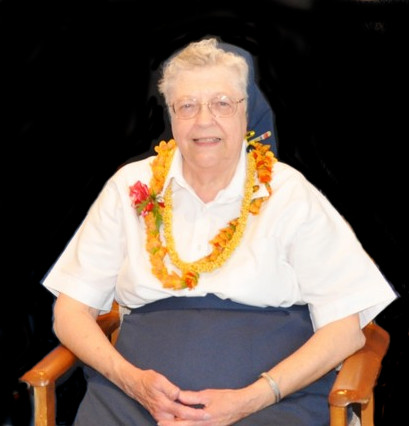
A letter from Sister Maurice, Daughter of Charity
When the newly released movie: “Three Stripes in the Sun” was shown to us in 1955, I was in the first year of my initial formation (the Seminary) in the Daughters of Charity of St. Vincent de Paul. The movie, which has since become a classic film, is the true story of the post-World War II first encounter of the American soldiers of the 27th Infantry Regiment, nicknamed the “Wolfhounds”, with the children of Holy Family Home in Osaka, Japan.
The missionary work of the French Daughters of Charity in Japan had begun in October, 1933, with the establishment of their first house and a hospital in Osaka. Like the rest of the population, the Sisters were struggling with the devastation of the war which ended in 1945. While trying to provide for the needs of the patients in the hospital and themselves, with only the bare essentials, they had to find ways to shelter and nourish the orphaned infants and children who were brought to them from the ruins of the bombed City.
By the Providence of God, the American soldiers of the Occupation Forces who were stationed in the area, met a Daughter of Charity, and discovered the plight of the children. The Sisters and Volunteers were taking care of about 200 children, sheltered in the nearby dilapidated wooden barracks that the Japanese Army had vacated. Moved with compassion, the Wolfhound soldiers began to support them with food, clothing, medical care and financial assistance. They provided materials and labor for the building of the first real “home” for the orphans, Holy Family Home. Because of their work of love, the children still call them the “Gentle Wolfhounds”.
In 1954, one year before the movie was released the first four American Daughters of Charity had arrived in Wakayama, Japan, another city that had suffered severe damage during the war. So, watching the movie had a special meaning for us. It did not occur to me then that, 10 years later, in 1964, I would follow the Sisters as a missionary in Japan.
After Japanese Language study, I was sent to Wakayama to work as a nurse at the first Catholic hospital for handicapped children that our American Sisters had founded. My relationship with the Wolfhound soldiers began twelve years later in 1978 when I was missioned to Osaka, to the same Holy Family Home that was shown in the movie. The Baby Home and two ferroconcrete buildings had been added to the wooden structure that was built with the help of the soldiers. At that time, the Sisters’ community was in that same original building where some children were still living.
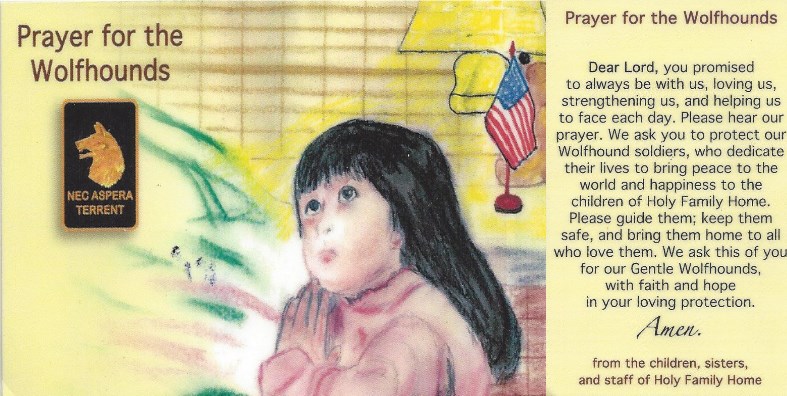 During my 36 years in Osaka, in addition to my nursing duties with the infants and toddlers in the Baby Home and the older children in Holy Family Home, my responsibilities included all of the English work for the institution. This meant that I was the contact person and correspondent for Holy Family Home Holy Family Home and the 27th Infantry Regiment Wolfhounds, the liaison for the soldiers’ Christmas visits and the children’s summer visits to Hawaii. I also did translation work and assisted with procedures for adoptions through International Adoption agencies. I wrote English letters for the Director, and accompanied English-speaking visitors and adoptive parents who came to meet the child to be adopted.
During my 36 years in Osaka, in addition to my nursing duties with the infants and toddlers in the Baby Home and the older children in Holy Family Home, my responsibilities included all of the English work for the institution. This meant that I was the contact person and correspondent for Holy Family Home Holy Family Home and the 27th Infantry Regiment Wolfhounds, the liaison for the soldiers’ Christmas visits and the children’s summer visits to Hawaii. I also did translation work and assisted with procedures for adoptions through International Adoption agencies. I wrote English letters for the Director, and accompanied English-speaking visitors and adoptive parents who came to meet the child to be adopted.
I fondly recall those years at Holy Family Home as the happiest of my 50 years in Japan. I was, and still am, truly blessed with the friendship of so many good people, the soldiers, adoption families, etc. The battalion leaders and soldiers of the Regiment rotate every 2-3 years, so it can be said that I have had the joy of “knowing” more than ten generations of Wolfhounds!
Special mention must be made of The Historical Society of the 27th Infantry Regiment. No other infantry can boast of a unique relationship like this between American soldiers and children in a child care institution. Unlike the orphans of post war Japan, these are children who have been abandoned, abused, or come from broken homes. I am inspired by the brotherhood exemplified by these older veterans and their devotedness to the happiness of the children. Along with the younger soldiers in active service, they preserve the legacy begun in 1949, and pass it on from one generation to the next. Their loving friendship and moral support remain firmly fixed in the life and history of the institution.
Last year I had to leave my loved mission in Japan for health reasons, and now I live in the Daughters of Charity retirement home in Evansville, Indiana. Fortunately however, I am still in contact with the soldiers. Also, to my surprise, I have found out that there are veteran Wolfhounds living right here in Evansville! What a “small world”!
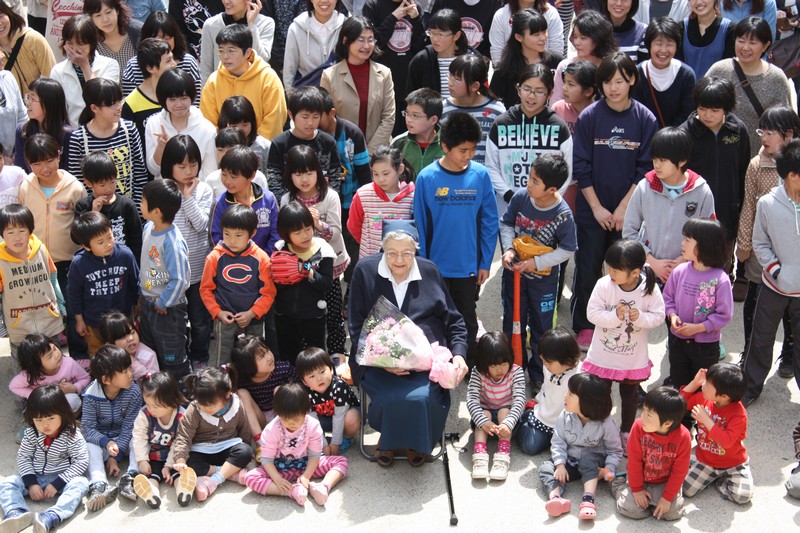
Official "Wolfhounds Day", July 29, 2016
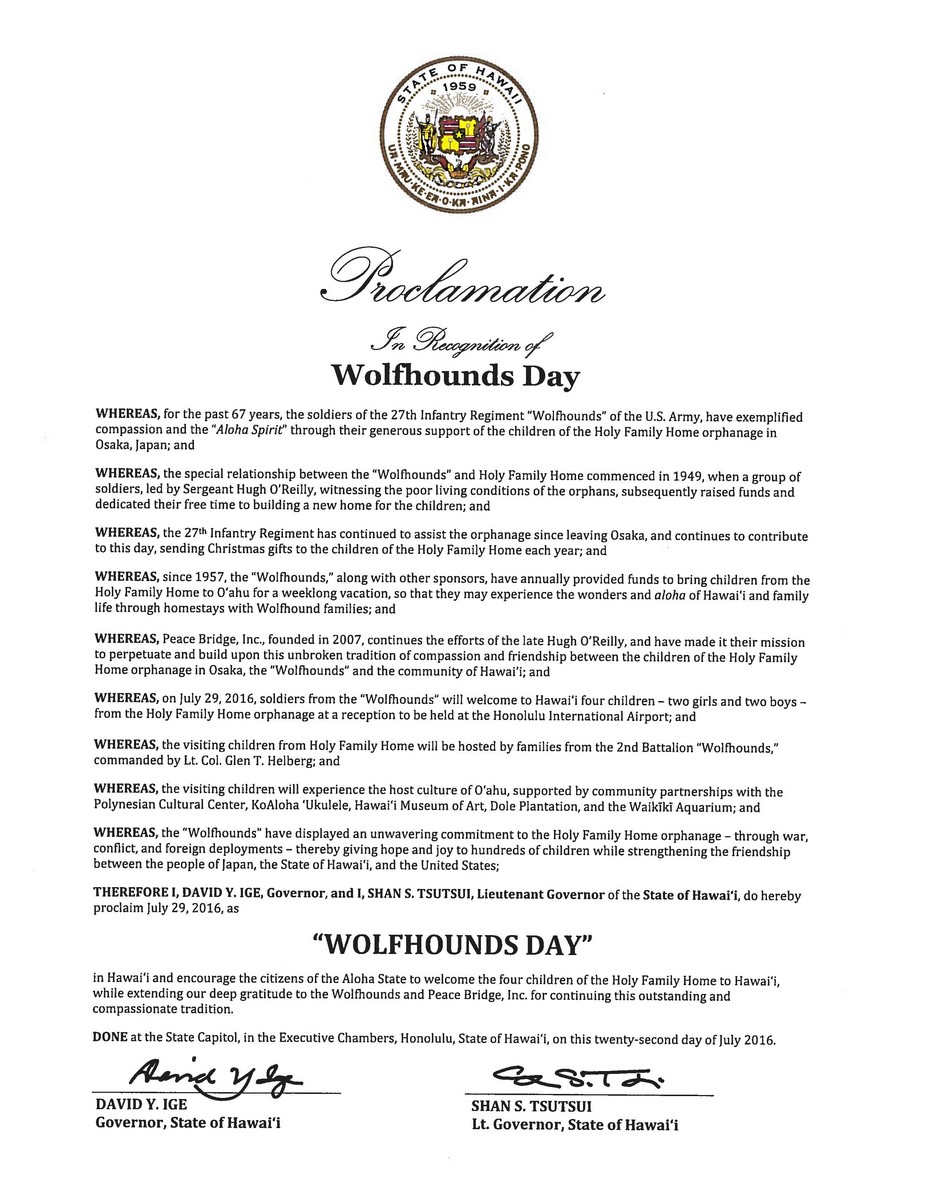
Articles and Links
Articles about the Wolfhounds and the Holy Family Home
Other WolfhoundPack.com content about the Holy Family Home
Other Sites
| Peace-Bridge.org, continuing the tradition of Wolfhound support of the Holy Family Home |
| Three Stripes in the Sun, motion picture, on Wikipedia |

